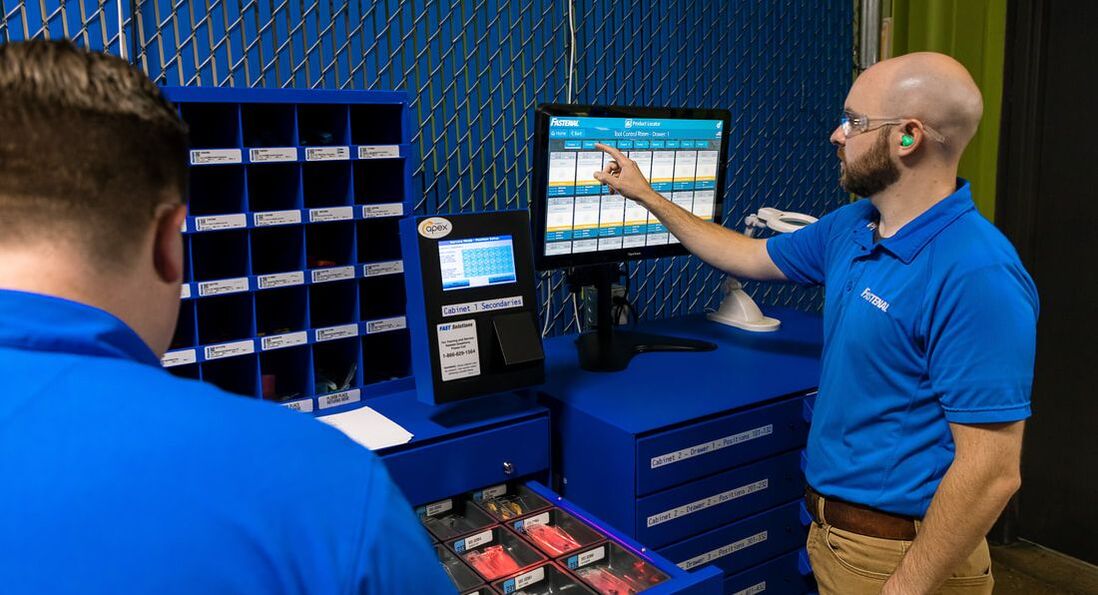How one company saved big by going Lean
August 22, 2022
By Matt Kriner | TCO Expert
By Matt Kriner | TCO Expert
|
Name three ways to find cost savings. Take as long as you need, but I should mention that, regardless how much time you take, you’re unlikely to find one of the most powerful options.
And at first, neither did I. The thought came to me while we were out working with a company that manufactures lifting equipment. They have 45,000 bins for parts, just to give you a sense of the scale. So how did a company that big find cost savings? A technology-infused supply chain partnership. That’s the short version, anyway. The long version is, well, longer. From the start My job was to examine the processes that go into creating the lift systems you see on construction sites or really anytime someone needs to work at height.
In short, the goal was to find improvements to workflows and lower their total cost of ownership. Also, because they use specially coated OEM hardware, stock-outs and sourcing delays were unacceptable. Where to turn While we were already working with them, this was still very much a “dip the toes in the water” situation to see if Fastenal could help on a larger scale. What they wanted wasn’t a big ask. It boiled down to having a supplier they could rely on to meet their service expectations. They were looking to improve their lineside stocking locations, preferably with a system that was intuitive, able to be replicated, and dynamic. That was important. It had to be dynamic enough to ensure they had the proper quantities of all parts where they needed them … when they needed them. Can it scale? This is a big company with a lot of facilities in different cities. They basically have a spiderweb of interconnected teams. We were asked to supply a small set of SKUs to assist in filling their supply chain. These first offerings were standard stock items for Fastenal, so we were able to react quickly to shore up their supply chain. Initially, Fastenal’s Lean Solutions team was brought in to assist with appropriate storage solutions to ensure a smooth transition on that small set of SKUs. But that was just the tip of the iceberg. When they liked what they were seeing from our small test, they decided to shift more over to us. At that point, we built out a point-of-use inventory layout and created a system of bins, labels, and the technology needed to keep things humming. And again, their scale drove our work. They have a dozen facilities in a 60-mile radius. That meant we needed to fine-tune the local service. Each location needed to have that same intuitive, dynamic system for inventory. Implementation, not disruption
When we entered this new partnership, both sides were dealing with the pandemic. So, naturally, that made the implementation process … challenging. Still, we worked out a plan and executed. The goal was simple: Keep the production lines running with very few interruptions. In the end, the implementation was a success, and there were no line-down situations. To pull it all off, we used Lean manufacturing principles. From spaghetti diagrams to the DMAIC process, everything was in play. We started by operating the incumbent supplier’s warehouse, but then we also found and outfitted a new 50,000-square-foot facility as a long-term solution. This became our base for sourcing, ordering, and developing a world-class supply chain program. Part of the work was setting up the inventory management system to continually supply their production lines with the special OEM parts on a daily basis. That meant Fastenal took over the stocking for 1,100 individual rack locations containing 45,000 bins. This freed up resources that the customer could put back to use elsewhere in production. Making a big move Here’s a stat for you. At one point, Fastenal moved 750,000 pounds of product in eight working days. How? And why? As we reached the 12-month anniversary of the partnership, we developed and executed a disposition plan for the remaining inventory. Part of this project required Fastenal to handle a significant amount of inventory left over from the previous supplier. So, we worked up a list of parts, and then pulled, packed, and delivered roughly 750,000 lbs. of inventory in eight days. This was done exclusively on the customer’s behalf and completely without their involvement. Doing it this way saved them hundreds of paid hours and roughly 15,000 square feet of warehouse space. Bottom line It’s still a work in progress, but we’ve started an intuitive stocking program for their local teams. For the first time, they have complete visibility into their entire lineside hardware offering. Add in that they now have a baseline quantity per bin (peace of mind) and Fastenal doing the stocking (time savings), and they seem pretty happy with the outcome. At the start, I mentioned finding ways to create cost savings. Partnership can be a powerful asset. With the right partner, you can reap benefits up and down your supply chain without taking on new work. Today, companies that specialize in inventory management can take over the sourcing and stocking of critical parts. They have people (like me) with decades of experience in Lean manufacturing. This is the kind of partnership where you get time back in the day, AND you have experts working to ensure your supplies are aligned with production needs. So, if you’re looking to strengthen your supply chain, look for a partner. Vertical Divider
|
I’m always happy to help with supply chain questions. Feel free to reach out to me at [email protected].
Like what you're seeing here? Subscribe to the Blue Print for FREE and get the magazine sent right to your address. |



